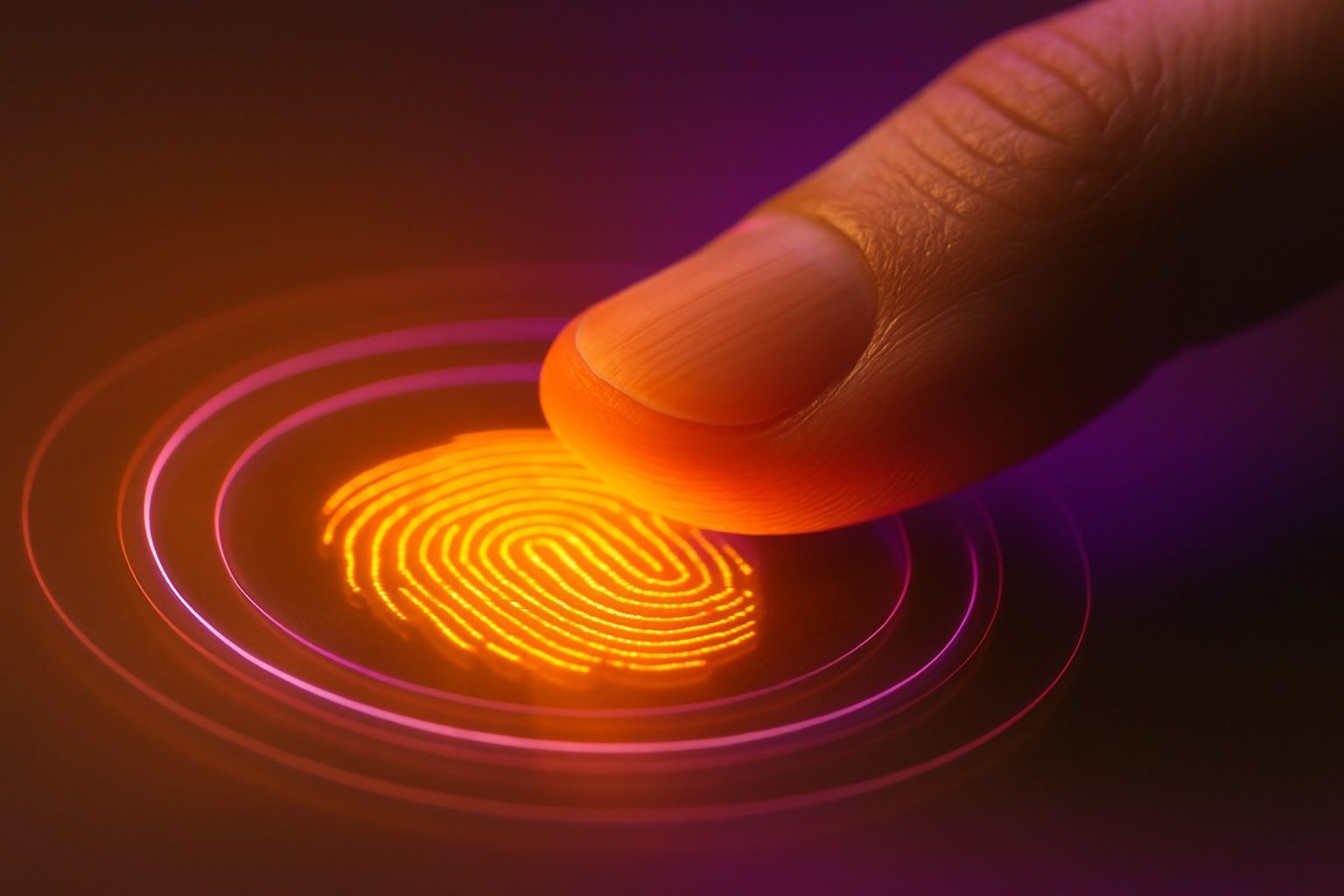- Intesi Group of Italy and iGrant of Sweden launched the EUDI Wallet Business Wallet, a cross-border platform that combines qualified electronic signatures with Qualified Electronic Attribute Attestations for legally binding transactions.
- Google and Germany’s Sparkasse announced a first-of-its-kind online age-verification service that uses Google Wallet’s Credential Manager API with zero-knowledge cryptography to enable one-click age checks without exposing personal data.
- authID and Prove joined to embed authID’s biometric selfie verification and the PrivacyKey tokenization feature into Prove’s onboarding platform to detect synthetic identities and deepfake impersonations.
- Evo Tech released Evolution 1.0, a modular AI-agent platform that analyzes images, video, audio, and text to spot deepfakes and assigns a Reliability Score to content for law enforcement use.
- NEXT Biometrics introduced the L1 Slim thin fingerprint sensor in June, compliant with MOSIP standards to simplify national ID and financial use cases.
- The UK’s Data (Use and Access) Act 2025 received Royal Assent on 19 June 2025, formalizing the UK Digital Identity Trust Framework with a statutory registry and trustmark system.
- The EU released three Implementing Acts for the European Digital Identity Wallet in late June 2025 on trust service qualification, conformity assessment body accreditation, and risk management, with public feedback through mid-July and an age-verification app planned by July.
- A June 2025 event saw the leak of 16 billion login credentials from multiple data sets, underscoring the threat to legacy authentication and the push toward passwordless and MFA.
- Tanzania announced in July 2025 a pilot for infant biometrics as part of its national digital ID program, issuing Jamii Number IDs at birth and linking newborn records to the mother’s ID until robust infant biometrics are validated.
- Passkeys have reached mainstream status by mid-2025, with over 1 billion users activated and more than 15 billion accounts enabled for passkey sign-ins, around 57% consumer awareness, and forecasts that about one-quarter of the world’s top 1,000 websites will offer passkey logins by end-2025.
June and July 2025 saw a flurry of activity in digital identity and authentication worldwide. New products and platforms were launched – from innovative digital ID wallets to advanced biometric and blockchain-based tools. Governments introduced or updated policies and initiatives spanning national digital IDs, online age verification, and regulatory frameworks. At the same time, cybersecurity incidents underscored the risks of legacy authentication, while industry responded with stronger measures against threats like mass credential leaks and deepfake fraud. Ongoing advances in authentication technology (e.g. passkeys, biometrics, decentralized identity) gained momentum, supported by market forecasts and expert commentary emphasizing a shift toward more secure, user-centric identity solutions. The following report organizes the key news and trends from June–July 2025, with each claim backed by credible sources.
New Digital Identity Products & Platform Launches
- EUDI Business Wallet Solution: European digital identity projects progressed with a new business wallet integration. Italy’s Intesi Group and Sweden’s iGrant launched an EUDI Wallet solution combining qualified electronic signatures with Qualified Electronic Attribute Attestations (QEAAs) for cross-border document signing [1]. This “one-stop-shop” platform, part of EU Digital Identity Wallet pilots, enables legally binding transactions via organizational wallets and accelerates adoption of the European Business Wallet for companies [2].
- Google & Sparkasse Age Verification: Tech giant Google teamed up with Germany’s Sparkasse bank network on a “first-of-its-kind” digital age verification service. Announced in early July, the collaboration will let users prove their age online by presenting a trusted credential from their bank via Google Wallet [3]. The system uses Google’s Credential Manager API with zero-knowledge cryptography to enable seamless one-click age checks in Android/Chrome without exposing personal data [4]. The rollout is expected in the coming months as Europe tightens requirements to protect minors online.
- Biometric Authentication & Deepfake Defense: Identity verification providers integrated new tools to fight fraud. In July, authID formed a strategic partnership with Prove to embed authID’s biometric authentication (selfie identity verification and a new PrivacyKey tokenization feature) into Prove’s platform for detecting synthetic identities and deepfake impersonations during onboarding [5]. Prove’s CEO noted this added “trust layer” prevents spoofing “without adding friction” for users [6]. Also launching was Evo Tech’s “Evolution 1.0” platform – a modular suite of AI agents that analyze images, video, audio, and text to spot deepfakes using techniques like facial symmetry analysis, lip-sync timing, and acoustic resonance checks [7]. A Reliability Score is generated for each piece of content to assist law enforcement and intelligence agencies in deepfake detection.
- Other Notable Launches: The period saw continued innovation in authentication hardware. For example, NEXT Biometrics introduced a new thin fingerprint sensor (L1 Slim) compliant with MOSIP standards in June, aiming to simplify national ID and financial use cases [8]. Startup Fuse Identities debuted a biometric access smart card with an embedded Fingerprint Cards sensor for secure physical entry control [9]. These launches reflect growing demand for convenient yet stronger identity verification across sectors.
Government Policies & Digital ID Initiatives
United States – Policy Reversal: In early June, the U.S. administration dramatically shifted course on digital identity. President Trump issued an executive order on June 9 rolling back key Biden-era digital identity provisions [10]. This order rescinded plans to pilot mobile driver’s licenses (mDLs) for online citizen verification and halted efforts by agencies like Social Security to help verify identities for public benefits [11]. The White House justified the rollback with claims about “U.S. government issued digital IDs for illegal aliens” facilitating fraud [12] – a false premise, as the original policies did not offer IDs to undocumented immigrants. Experts criticized the move: “Nothing in [January’s] EO included a mandate for the U.S. government to issue digital IDs to anybody…,” noted Jeremy Grant of the Better Identity Coalition, adding that the now-gutted initiatives had broad bipartisan support and were praised by fraud prevention experts [13]. Former officials warned the reversal undermines anti-fraud efforts and could leave the U.S. further behind on secure digital identity [14].
Europe – Digital Identity Frameworks: European governments pressed ahead with digital ID reforms. In the UK, the Data (Use and Access) Act 2025 received Royal Assent on 19 June, establishing a legal foundation for trusted digital identities [15]. Part 2 of this Act formally enshrines the UK Digital Identity Trust Framework – setting standards, governance and oversight in law for the first time [16]. This means identity providers will be subject to a statutory registry and trustmark system, enabling citizens and businesses to use certified digital ID services with confidence across the UK economy. Meanwhile, the EU adopted new rules to advance its bloc-wide digital wallet. In late June, Brussels released three fresh Implementing Acts under the forthcoming European Digital Identity (EUDI) Wallet regulation, covering trust service qualification, accreditation of conformity assessment bodies, and risk management for non-qualified services [17]. Public feedback on these proposals was opened through mid-July 2025 [18], reflecting the EU’s collaborative approach to finalizing standards. Separately, the EU prepared to launch an official age verification app by July to help online platforms verify users’ ages without exposing personal data [19]. The app is part of a broader EU push (under the Digital Services Act) to protect minors online, and it coincides with investigations into adult websites for failing to implement adequate age checks [20]. “The protection of minors is a very important priority for us,” emphasized Henna Virkkunen, an EU tech policy chief, noting that if industry doesn’t voluntarily improve age safeguards, legislation will follow [21].
Global & National Initiatives: Other regions made strides in digital identity during this period. Ukraine aligned with European standards by adopting a new regulation (Resolution No. 689) defining the technical and operational requirements for its own digital ID wallet [22]. The wallet will comply with EU eIDAS 2.0 rules and store both Ukrainian and EU identity documents, allowing Ukrainian citizens abroad to access services and EU citizens in Ukraine to do the same [23]. In Africa, interoperable digital identity was a hot topic at the 2025 Internet Governance Forum (IGF) in late June. Experts at IGF (held June 20–27 in Norway) renewed calls for a unique pan-African digital ID usable across borders [24]. They urged African nations to federate identity data systems and build trust frameworks that respect sovereignty and privacy while enabling secure cross-border verification [25]. Pilot programs pairing neighboring countries (e.g. Nigeria and Cameroon) to test interoperability were suggested as first steps, drawing inspiration from existing regional schemes like the ECOWAS biometric ID card [26] [27]. In Nigeria, digital ID is being leveraged for humanitarian aid: A partnership between the government and the UN World Food Programme introduced a digital wallet + biometric ID verification system to deliver cash assistance and food vouchers to over 750,000 internally displaced people [28]. The system uses fingerprint checks and digital vouchers to ensure transparency and prevent fraud or duplicate claims in aid distribution [29]. Nigeria’s humanitarian minister hailed it as a “great step” that not only directs aid to the right beneficiaries but also “brings dignity” to how vulnerable people receive support [30].
Cybersecurity Threats Highlight Identity Risks
Major security incidents in mid-2025 underscored the ongoing vulnerabilities in identity and access systems, fueling calls for stronger authentication practices. In June, researchers exposed what may be the largest-ever compilation of stolen usernames and passwords: 16 billion login credentials leaked online [31]. The trove – containing account passwords for popular services like Google, Facebook, Apple and more – was not the result of a single breach, but rather an aggregate of 30 data sets from past breaches and malware infections [32] [33]. Cybercriminals likely amassed these credentials via “infostealer” malware over time, then briefly dumped them in public. The sheer scale (equivalent to 2× the Earth’s population in credentials) suggests many individuals had multiple accounts compromised. Security experts warned this incident offers attackers “unprecedented access” to victim accounts [34] and might lead to a spike in account takeovers, spam, and identity theft. In response, cyber hygiene advice was emphatic: Users should immediately change passwords (especially if re-used across sites), enable multi-factor authentication, or better yet upgrade to passwordless login methods [35]. If remembering many passwords is too hard, use a password manager or passkey, experts urged [36]. Indeed, the Identity Theft Resource Center noted that had those 16 billion logins been passkeys instead of passwords, they would be useless to criminals – “you cannot lose a passkey like a password… Identity criminals cannot steal it because it is unique to you and bound to a company’s website” [37]. This reflects a broader consensus that password-only security is increasingly untenable at scale.
Another growing threat in 2025 is the misuse of deepfakes and AI-driven identity fraud. As facial recognition and biometric logins proliferate, attackers have begun exploiting AI-generated fake faces, voices, and videos to impersonate individuals. Troublingly, the public may underestimate the danger. A recent survey in Singapore found over 75% of people were confident they could spot a deepfake, yet when tested, only 25% actually discerned fake media correctly [38]. This overconfidence gap – many think they can “see through” deepfakes, but most cannot – creates a “canny valley” in which victims are easily fooled [39]. To combat this, both technology and policy responses are advancing. Authentication firms are adding liveness detection and deepfake screening into their identity proofing workflows (for example, Prove’s integration of authID’s selfie biometrics aims to automatically block deepfake attempts during onboarding [40]). New detection platforms like Evo Tech’s analyze multimedia content for telltale signs of AI manipulation, assisting banks and governments in vetting identities [41]. Lawmakers are also stepping in: Denmark is drafting legislation to give citizens legal ownership of their likeness (face and voice) to fight malicious deepfakes [42]. The EU’s forthcoming AI Act will mandate transparency (e.g. watermarks or labels) for deepfake content, and countries such as France and the UK have criminalized certain non-consensual deepfakes [43]. All these efforts recognize that sophisticated impersonation attacks could erode trust in digital identity systems if left unchecked – a multi-pronged approach (public education, better AI detection, and updated laws) is emerging to address the risk.
Advances in Authentication Technologies (Mid-2025)
Passkeys and Passwordless Adoption: By mid-2025, passkeys – FIDO Alliance’s standard for passwordless login using public-key cryptography – have moved from early adoption into the mainstream. Over 1 billion users have now activated at least one passkey for their online accounts [44], and the supporting ecosystem has grown dramatically. According to the FIDO Alliance, more than 15 billion accounts across websites and apps are enabled for passkey sign‑ins, thanks to broad support built into major operating systems and browsers [45]. Consumer awareness of passkeys jumped to ~57% (from 39% two years prior), and many who try passkeys prefer them over passwords [46]. Industry leaders predict rapid expansion by year’s end – FIDO’s Executive Director Andrew Shikiar expects 1 in 4 of the world’s top 1,000 websites to offer passkey logins by the close of 2025 [47]. Notably, large financial institutions known for caution are embracing passwordless tech: major banks (Bank of America, Wells Fargo, etc.) have begun rolling out passkey support for customers in 2025, a strong endorsement of its security and usability benefits [48]. Enterprises are also deploying passkeys internally to eliminate phishing and reduce password reset costs. All these signs point to an authentication “revolution” underway – one where cryptographic login credentials tied to your device (or biometrics) replace the decades-old password model. Early results are promising: organizations report up to 98% drops in account takeover fraud and significantly faster login times after implementing passkeys [49]. With Apple, Google, Microsoft and other platforms fully on board, the consensus is that passwordless authentication is here to stay.
Biometric Innovations: Biometric authentication continues to advance, tackling new frontiers and user populations. In a pioneering move, Tanzania announced it will pilot infant biometric registration starting in July 2025 as part of its national digital ID program [50]. The goal is to capture a biometric record (such as fingerprint or footprint) for children under five, enabling each child to receive a digital ID number at birth alongside their birth certificate [51] [52]. Supported by UNICEF, the pilot will test specialized scanners on infants in select regions. This is an ambitious attempt to solve a long-standing gap – traditionally, biometric IDs are issued only to adults due to the difficulty of capturing biometrics from babies (fingerprints of infants are faint and change as they grow). Tanzania’s ID agency acknowledged the technical challenges and plans an interim solution: for now, a newborn’s digital identity will be linked to the mother’s ID until robust infant biometric methods are validated [53]. “Infant biometrics remain a niche capability” despite recent R&D progress, the agency’s director noted, but vendors are making strides (one firm showcased the first infant fingerprint scanner at ID4Africa 2025) [54]. If successful, Tanzania’s approach – assigning a Jamii Number ID at birth – could improve access to healthcare, education and services by establishing legal identity from day one. Elsewhere, biometric tech is getting thinner and more flexible: companies in June unveiled ultra-thin fingerprint sensors that can embed in credit cards or smartphones without bumps [55], and multimodal systems combining face, iris, and voice recognition are being trialed for higher security applications. The trend is clear: biometrics are expanding to new use cases, while also addressing prior limitations (e.g. liveness detection to foil spoofing, age variance, etc.).
Decentralized and Self-Sovereign Identity: Another key development area is decentralized identity, which uses blockchain and distributed ledger technology to give users more control over their personal data. Market analysis indicates growing interest in self-sovereign identity (SSI) principles, especially in highly regulated industries. A recent Juniper Research study predicts that by 2029, integration of SSI will significantly enhance privacy and security in digital ID verification – for example, allowing individuals to share only necessary identity attributes via encrypted wallets, rather than handing over full documents [56]. This approach can reduce honeypots of personal data and put users in charge of who accesses their information. Major government initiatives are reinforcing the shift towards decentralized credentials: under the EU’s upcoming eIDAS 2.0 regulation, all member states must offer citizens a European Digital Identity Wallet by 2026, enabling cross-border acceptance of national eIDs and credentials [57]. These wallets, which employ decentralized storage and interoperable standards, will let people prove things about themselves (age, qualifications, health insurance, etc.) without centrally validating each time – a big change in the digital trust infrastructure. The EU is actively encouraging vendors to build wallet solutions that align with its standards for security and privacy [58]. Private-sector efforts like the OpenWallet Foundation are also contributing open-source code to support interoperable ID wallets globally. While SSI is still emerging, mid-2025 saw concrete steps: new pilots for verifiable credentials (such as digital driver’s licenses) rolled out in parts of the US and Canada, and banks in Asia began experimenting with blockchain-based KYC identity networks. These experiments, alongside regulatory mandates, suggest decentralized identity is moving from theory to practice as a complement to traditional ID systems.
Market Trends, Forecasts & Expert Insights (June–July 2025)
Industry analysts and stakeholders provided valuable insight into the digital identity market’s trajectory during this period. Market forecasts remain bullish on growth in the identity and authentication sector. For instance, Juniper Research projected that global spending on digital identity verification will soar by 74% over the next five years – from around $15.2 billion in 2024 to $26 billion by 2029 [59]. This robust expansion is attributed to organizations investing in smoother, more automated verification solutions to meet security challenges. In particular, Juniper’s study highlighted rising adoption of behavioral biometrics – analyzing user behavior (typing patterns, mouse movements, etc.) to silently flag impostors – as a key technology enabling earlier and more efficient fraud detection in identity checks [60]. The research also anticipates wider incorporation of self-sovereign identity elements (e.g. decentralized credential wallets), which can improve privacy and compliance in sectors like finance and healthcare by minimizing the sharing of raw personal data [61]. Another driver is government programs (such as Europe’s eIDAS 2.0 wallet rollout) creating a massive new market for compliant digital ID solutions by 2026 [62]. In short, both enterprise demand and public-sector mandates are fueling a boom in identity tech, and analysts expect the identity market to double in value within the latter half of the decade.
Consumer attitudes reflect these trends as well. A global survey released around World Passkey Day 2025 (May 2025) found that 74% of consumers are now aware of passkeys, and among those familiar, a solid majority believe passkeys are more convenient (54%) and more secure (53%) than passwords [63]. Notably, 69% of respondents had already enabled a passkey on at least one account, and 38% of passkey users reported turning it on “whenever possible” [64]. These data points, collected across the US, UK, and Asia, indicate rapidly improving public comfort with passwordless authentication. High-profile security incidents are also influencing opinion – after news of mega-breaches and leaks, consumers increasingly say they would abandon purchases or accounts rather than deal with forgotten passwords [65], a pain point passkeys can eliminate. Industry experts are seizing on this momentum. “The establishment and growth of World Passkey Day reflects the fact that organizations of all shapes and sizes are taking action on the imperative to move away from passwords… which imperil the very foundations of our connected society,” said Andrew Shikiar, Executive Director of the FIDO Alliance [66]. Over 100 tech companies, banks, and service providers signed FIDO’s 2025 Passkey Pledge, committing to support passwordless logins in solidarity. This collective effort by industry underscores a broad consensus: password-based security must be phased out in favor of phishing-resistant methods.
Leaders in government and cybersecurity echoed the call for stronger digital identity protections. In a June interview, Kemba Walden, former acting U.S. National Cyber Director, warned that securing digital identity is a national priority. “If we don’t secure our digital identity infrastructure, we are giving the upper hand to cyber criminals and nation states to do harm,” Walden cautioned, emphasizing that cyber adversaries actively exploit weaknesses in identity systems to defraud individuals and penetrate critical infrastructure [67]. She and other officials noted that recent fraud epidemics (e.g. pandemic relief identity theft) cost governments hundreds of billions, and closing those gaps will require concerted action – from implementing modern ID verification tools to establishing clear identity governance frameworks. This aligns with comments from private sector executives: many CISOs now champion identity as “the new perimeter” in cybersecurity, shifting investments toward Zero Trust identity architectures, continuous user authentication, and collaboration with identity providers.
Expert commentary over mid-2025 also addressed the balance of security and user experience. At the Identiverse 2025 conference (held in June), analysts observed that customer IAM (Identity & Access Management) is evolving to eliminate friction – for example, invisible MFA techniques and risk-based authentication that authenticates low-risk logins silently. However, speakers also highlighted emerging challenges like AI in fraud (deepfakes, synthetic IDs) and the need for standards to keep pace. A Gartner analyst speaking at the conference predicted that by 2026, 20% of digital ID credentials in circulation will be decentralized or blockchain-based, up from practically zero today – a sign of the coming diversification of identity models. Another theme in expert discussions was privacy: as digital ID programs expand, ensuring privacy-by-design (minimal data disclosure, user consent, anonymity options) is key to public trust. The Good-ID movement and privacy advocates have been vocal in reviewing new digital ID systems for potential surveillance or exclusion risks. In late June, over 80 organizations and academics wrote an open letter raising concerns about any identity system with “phone-home” features that track users [68]. Their vigilance serves as a reminder that trust is the cornerstone of any identity solution – technology must be deployed in a way that preserves individual rights and fosters user confidence.
Conclusion
In summary, the June–July 2025 period marked an inflection point for digital identity and authentication worldwide. We saw cutting-edge solutions emerge – from Europe’s interoperable ID wallets and Google’s age-check app, to deepfake-resistant verification tools – all aimed at making identity proofing more secure yet seamless. Governments took both steps forward and backward: while countries like the UK, Ukraine, and Nigeria forged ahead with digital ID implementations to benefit citizens, the US at the federal level hit pause on its nascent digital identity efforts, igniting debate about how best to fight fraud. Massive credential leaks and sophisticated fraud schemes provided stark evidence that legacy authentication methods are under strain, accelerating the push toward passwordless and biometric security. Meanwhile, the market outlook for identity technologies remains extremely positive, backed by investments and the urgency to solve digital trust challenges. Experts across sectors agree on the end goal – an ecosystem where individuals can prove “I am who I claim” easily and safely, without exposing themselves to undue risk or complexity. Achieving that will require continued collaboration between industry innovators, policymakers, and civil society in the months and years ahead. The developments of mid-2025 show that this collaboration is well underway, as digital identity solidifies its role as a foundational element of our global digital infrastructure.
Sources: [69] [70] [71] [72] [73] [74] [75] [76] [77] [78] [79] [80] [81] [82] [83] [84] [85] [86] [87] [88] [89] [90] [91] [92] [93] [94] [95] [96] [97] [98] [99] [100] [101] [102] [103] [104]
References
1. www.biometricupdate.com, 2. www.biometricupdate.com, 3. www.biometricupdate.com, 4. www.biometricupdate.com, 5. www.biometricupdate.com, 6. www.biometricupdate.com, 7. www.biometricupdate.com, 8. www.biometricupdate.com, 9. www.globenewswire.com, 10. www.nextgov.com, 11. www.nextgov.com, 12. www.nextgov.com, 13. www.nextgov.com, 14. www.nextgov.com, 15. enablingdigitalidentity.blog.gov.uk, 16. enablingdigitalidentity.blog.gov.uk, 17. www.biometricupdate.com, 18. www.biometricupdate.com, 19. www.pymnts.com, 20. www.pymnts.com, 21. www.pymnts.com, 22. www.biometricupdate.com, 23. www.biometricupdate.com, 24. www.biometricupdate.com, 25. www.biometricupdate.com, 26. www.biometricupdate.com, 27. www.biometricupdate.com, 28. www.biometricupdate.com, 29. www.biometricupdate.com, 30. www.biometricupdate.com, 31. www.cbsnews.com, 32. www.cbsnews.com, 33. www.cbsnews.com, 34. www.cbsnews.com, 35. www.cbsnews.com, 36. www.cbsnews.com, 37. www.idtheftcenter.org, 38. www.biometricupdate.com, 39. www.biometricupdate.com, 40. www.biometricupdate.com, 41. www.biometricupdate.com, 42. www.biometricupdate.com, 43. www.biometricupdate.com, 44. ifeeltech.com, 45. ifeeltech.com, 46. ifeeltech.com, 47. ifeeltech.com, 48. ifeeltech.com, 49. ifeeltech.com, 50. www.biometricupdate.com, 51. www.biometricupdate.com, 52. www.biometricupdate.com, 53. www.biometricupdate.com, 54. www.biometricupdate.com, 55. thepaypers.com, 56. ctmfile.com, 57. ctmfile.com, 58. ctmfile.com, 59. ctmfile.com, 60. ctmfile.com, 61. ctmfile.com, 62. ctmfile.com, 63. fidoalliance.org, 64. fidoalliance.org, 65. fidoalliance.org, 66. fidoalliance.org, 67. www.nextgov.com, 68. www.aclu.org, 69. www.biometricupdate.com, 70. www.biometricupdate.com, 71. www.biometricupdate.com, 72. www.biometricupdate.com, 73. www.biometricupdate.com, 74. www.biometricupdate.com, 75. www.nextgov.com, 76. www.nextgov.com, 77. www.nextgov.com, 78. enablingdigitalidentity.blog.gov.uk, 79. enablingdigitalidentity.blog.gov.uk, 80. www.biometricupdate.com, 81. www.pymnts.com, 82. www.pymnts.com, 83. www.biometricupdate.com, 84. www.biometricupdate.com, 85. www.biometricupdate.com, 86. www.biometricupdate.com, 87. www.biometricupdate.com, 88. www.cbsnews.com, 89. www.cbsnews.com, 90. www.cbsnews.com, 91. www.idtheftcenter.org, 92. www.biometricupdate.com, 93. www.biometricupdate.com, 94. ifeeltech.com, 95. ifeeltech.com, 96. www.biometricupdate.com, 97. www.biometricupdate.com, 98. ctmfile.com, 99. ctmfile.com, 100. ctmfile.com, 101. ctmfile.com, 102. fidoalliance.org, 103. fidoalliance.org, 104. www.nextgov.com










